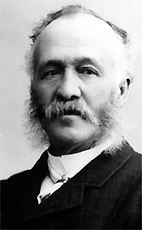 Senator M. H. Cochrane Photo credit: |
Matthew Henry Cochrane was a wealthy Montreal entrepreneur. In 1854, he founded a footwear manufacturing business, which quickly became one of the largest in Canada, with 300 employees and an annual revenue of approximately $8 million (in 2010 dollars). In 1864, he bought Hillhurst, a 750 acre (300 hectare) farm in Quebec’s Eastern Townships, near his childhood home of Compton, just north of the Vermont border. He used his wealth to stock his farm with the best purebred cattle, horses and sheep he could find in Canada and Great Britain, often paying unprecedented prices. Active in politics, Cochrane was appointed to the Canadian Senate in 1872. In search of the best livestock, in 1866 Cochrane attended the Provincial Exhibition in Hamilton, Ontario (later permanently located in Toronto and renamed the Canadian National Exhibition). There he purchased two first-prize Shorthorn cattle, including the heifer Snowdrop from John Miller/Thistle Ha’. Hugh Miller/Thistle Ha’ used to tell the story of John Miller’s trip to Hillhurst, but Duncan Marshall’s version is more detailed.
Source: Marshall, Duncan, Shorthorn Cattle in Canada, pp. 71-72, Dominion Shorthorn Breeders’ Association, 1932.
After the [Provincial Exhibition 1866] show Mr. Cochrane visited Thistle Ha’ and stayed overnight.
When John Miller got up to light the fire the next morning, he heard some one chopping at the wood pile and went out to discover Mr. Cochrane splitting wood. To Mr. Miller’s query he replied that he usually got up early and liked some exercise.
Mr. Cochrane then bought a second heifer, Princess Luan =4360= [Canadian pedigree number], but in doing so he insisted that Mr. Miller go down to Hillhurst with the heifers and consult with Mr. Cochrane about care of his cattle. Mr Miller made the trip and when Mr. Cochrane took him out to the stables to see the beasts most of the mangers were half full of straw and meal, some of which was packed down and had soured. A Scottish cattle feeder like John Miller couldn’t abide such a condition and he informed Mr. Cochrane that the feed troughs of cattle should be kept clean and sweet, and if a beast failed to clean up its feed the residue should be removed, and less feed given at the next meal. Mr. Cochrane was always prompt in his actions and he immediately got a fork and shovel, gave one implement to Mr. Miller and the two of them cleaned out all the mangers before they quit. Evidently Mr. Cochrane was in favor of getting immediate action.
After some further discussion about the Shorthorns, Herefords, and Ayrshires that Mr. Cochrane then had on hand, the proprietor of Hillhurst remarked that what he needed was a capable man in charge of his herds, one who knew cattle and how to care for and feed them, and asked Mr Miller if he knew where he could find such a man.
John Miller promptly recommended Simon Beattie who was then working for [John Miller’s uncle] George Miller at Riggfoot [farm in Markham, Ontario], but who John Miller knew was capable of taking charge of a large enterprise. Little did he know, however, what the far reaching effect of his recommendation would be, as Simon Beattie’s knowledge of cattle provided the complement to Cochrane’s enterprise and command of credit to make purchases…
Simon Beattie moved to Hillhurst in 1867. Based on Beattie’s advice, Cochrane began a campaign to import the best Shorthorns available in Britain, paying a then world-record price of 1,000 guineas (approximately $100,000 in 2010 dollars) for one cow in 1868. Cochrane-Beattie were soon legendary in the livestock industry, but that’s another story.
John Miller often travelled with Cochrane and Beattie during livestock buying trips to Britain in the 1870s. Although he had the utmost confidence in Beattie’s judgement, Senator Cochrane clearly still valued a second opinion from John Miller.
